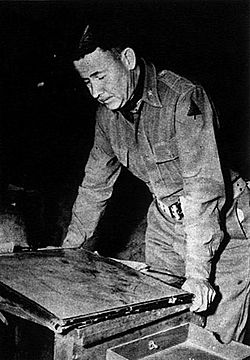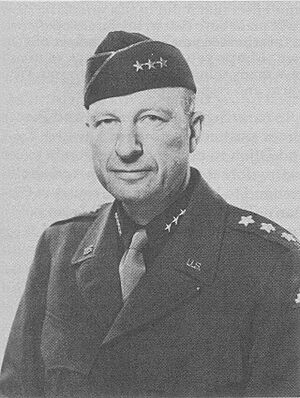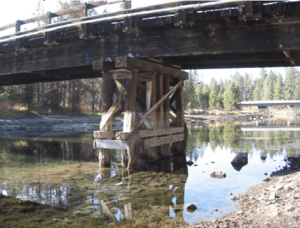Oregon Maneuver facts for kids
Quick facts for kids Oregon Maneuver |
|||||
|---|---|---|---|---|---|
| Part of World War II training | |||||
 Blue Force officer during Oregon Maneuver |
|||||
|
|||||
| Belligerents | |||||
| Commanders and leaders | |||||
The Oregon Maneuver was a huge military training exercise. It took place in Central Oregon, United States, from September to November 1943. This exercise helped prepare United States Army units for World War II. About 100,000 soldiers took part.
The main headquarters for the training was at Camp Abbot, near Bend, Oregon. Soldiers practiced different war situations. They were divided into two teams: the Red Force and the Blue Force. After this training, the soldiers went to fight in Europe or the Pacific.
Contents
Why Was This Training Important?
The Oregon Maneuver was the biggest military exercise ever in the Pacific Northwest. Over 100,000 soldiers participated. Many came from nearby army camps like Camp Adair and Camp White. Camp Abbot was chosen as the main base because it had good military buildings and was in a central location.
The training area covered more than 10,000 square miles (26,000 km²) across seven counties in eastern Oregon. This included most of Deschutes County, Oregon. It also included parts of four national forests. The area was shaped like a triangle. Sisters, Oregon was in the northwest, Burns, Oregon in the northeast, and Valley Falls, Oregon in the south.
Who Were the Teams?
The soldiers were part of the army's IV Corps. Major General Alexander Patch led this group.
- The Red Force was mainly the 96th Infantry Division. James L. Bradley was their commander. They played the role of the defenders.
- The Blue Force was made up of the 91st Infantry Division and the 104th Infantry Division. Gilbert R. Cook led them. They were the attackers.
The training involved different types of military units. These included infantry (foot soldiers), tanks, artillery (big guns), air force planes, and engineers. They practiced five main war problems. These included attacking and defending river lines. Army planes helped the ground forces from airfields nearby. Each training phase lasted two to three days without stopping. This helped soldiers get used to real combat conditions.
How Did the Training Happen?
Planning for the Oregon Maneuver started in spring 1943. By July, preparations were underway. Army engineers built airfields and supply depots. The Signal Corps set up a communication network.

In August, the main groups of soldiers arrived. They camped along U.S. Route 20 between Sisters and Bend. Oregon officials warned people about heavy military traffic. They asked the public to follow directions from military police.
The first part of the training was near Sisters, Bend, and Redmond. This lasted four weeks. Soldiers practiced live-fire exercises. Combat engineers built bridges over the Deschutes River. They also built roads. Medical teams were on site to help sick or injured soldiers. Army supply teams worked day and night. They moved food, water, fuel, and equipment to the training areas.
The Mock Battles
In mid-September, the Red Force set up a defensive line east of Bend. The Blue Force attacked them. The Red Force had to retreat further east. They set up a new line near Hampton Mountain. The Blue Force attacked again. After tough fighting, the Red Force pulled back towards Burns. They fought slowly as they retreated.
The Red Force left the town of Burns. They moved to positions southwest of the city. The final battle happened east of Wagontire, Oregon. It was near Silver Creek. This final battle lasted three days. The Red Force held strong positions on high ground. The larger Blue Force used tanks to lead their attack. They pushed back the Red Force until they could no longer hold their line.
Lieutenant General Lesley J. McNair, a top army leader, watched the final phase. He said the maneuver was a success. He noted that the rugged High Desert area was excellent for training. On October 13, 1943, General Patch officially ended the maneuver. He said both Red and Blue forces had completed their training goals. Soldiers started leaving the area in early November. The army promised to fix roads damaged by tanks.
The War Department said the high desert was perfect for training. The clear, cold weather helped soldiers march long distances. It also allowed planes to fly almost constantly. Temperatures could change a lot, sometimes by 50°F (28°C) in a day. This tested the soldiers in many conditions. Even when temperatures dropped below freezing, the soldiers stayed healthy.
What Happened After the Training?
After the Oregon Maneuver, the three divisions went to fight.
- The 91st Infantry Division went to North Africa. Then they fought in Italy.
- The 96th Infantry Division went to Hawaii. They prepared for the invasion of the Philippines. They fought in the Battle of Leyte and other battles there. They also fought at Okinawa.
- The 104th Infantry Division landed in France in September 1944. They fought in northern France, the Rhineland, and central Germany.
The only structure built during the maneuver that lasted a long time was the General Patch Bridge. It was in the Deschutes National Forest. The Forest Service took down the bridge in 2008 because it was no longer safe.
In 2009, the Oregon Legislature honored the Oregon Maneuver. They named parts of U.S. Route 97 and Oregon Route 126 the World War II Veterans Historic Highway. This was to remember the largest military training exercise ever held in the Pacific Northwest.



